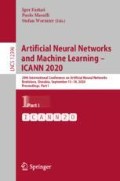Abstract
Neural networks, especially deep architectures, have proven excellent tools in solving various tasks, including classification. However, they are susceptible to adversarial inputs, which are similar to original ones, but yield incorrect classifications, often with high confidence. This reveals the lack of robustness in these models. In this paper, we try to shed light on this problem by analyzing the behavior of two types of trained neural networks: fully connected and convolutional, using MNIST, Fashion MNIST, SVHN and CIFAR10 datasets. All networks use a logistic activation function whose steepness we manipulate to study its effect on network robustness. We also generated adversarial examples with FGSM method and by perturbing those pixels that fool the network most effectively. Our experiments reveal a trade-off between accuracy and robustness of the networks, where models with a logistic function approaching a threshold function (very steep slope) appear to be more robust against adversarial inputs.
Access this chapter
Tax calculation will be finalised at checkout
Purchases are for personal use only
References
Deng, L., Yu, D.: Deep learning: methods and applications. Found. Trends Signal Process. 7(3–4), 197–387 (2014). https://doi.org/10.1561/2000000039
Goodfellow, I.J., Shlens, J., Szegedy, C.: Explaining and harnessing adversarial examples (2014). http://arxiv.org/abs/1412.6572
Krizhevsky, A.: Learning multiple layers of features from tiny images. Technical report TR-2009, University of Toronto (2009)
Kuzma, T., Farkaš, I.: Computational analysis of learned representations in deep neural network classifiers. In: IEEE International Joint Conference on Neural Networks (IJCNN) (2018)
LeCun, Y., Cortes, C., Burges, C.: The MNIST database of handwritten digits (2010). http://yann.lecun.com/exdb/mnist/
Montavon, G., Samek, W., Müller, K.R.: Methods for interpreting and understanding deep neural networks. Digit. Signal Proc. 73, 1–15 (2018). https://doi.org/10.1016/j.dsp.2017.10.011
Netzer, Y., Wang, T., Coates, A., Bissacco, A., Wu, B., Ng, A.Y.: Reading digits in natural images with unsupervised feature learning. In: NIPS Workshop on Deep Learning and Unsupervised Feature Learning (2011)
Papernot, N., McDaniel, P.D., Sinha, A., Wellman, M.P.: Towards the science of security and privacy in machine learning (2016). http://arxiv.org/abs/1611.03814
Ranjan, R., Sankaranarayanan, S., Castillo, C.D., Chellappa, R.: Improving network robustness against adversarial attacks with compact convolution. CoRR (2017). http://arxiv.org/abs/1712.00699
Rozsa, A., Rudd, E., Boult, T.: Adversarial diversity and hard positive generation. In: IEEE Conference on Computer Vision and Pattern Recognition Workshops (CVPRW), pp. 410–417 (2016). https://doi.org/10.1109/CVPRW.2016.58
Schott, L., Rauber, J., Brendel, W., Bethge, M.: Robust perception through analysis by synthesis. CoRR (2018). http://arxiv.org/abs/1805.09190
Su, J., Vargas, D.V., Kouichi, S.: One pixel attack for fooling deep neural networks. IEEE Trans. Evol. Comput. 23(5), 828–841 (2019). https://doi.org/10.1109/TEVC.2019.2890858
Sun, K., Zhu, Z., Lin, Z.: Enhancing the robustness of deep neural networks by boundary conditional GAN (2019). http://arxiv.org/abs/1902.11029
Szegedy, C., et al.: Intriguing properties of neural networks. In: International Conference on Learning Representations (2014). http://arxiv.org/abs/1312.6199
Xiao, H., Rasul, K., Vollgraf, R.: Fashion-MNIST: a novel image dataset for benchmarking machine learning algorithms (2017). https://arxiv.org/abs/1708.07747
Zhang, G., Yan, C., Ji, X., Zhang, T., Zhang, T., Xu, W.: DolphinAttack: inaudible voice commands. In: Proceedings of the ACM SIGSAC Conference on Computer and Communications Security, pp. 103–117 (2017)
Acknowledgement
This work was supported by projects VEGA 1/0796/18 and KEGA 042UK-4/2019. We thank anonymous reviewers for useful comments.
Author information
Authors and Affiliations
Corresponding author
Editor information
Editors and Affiliations
Rights and permissions
Copyright information
© 2020 Springer Nature Switzerland AG
About this paper
Cite this paper
Bečková, I., Pócoš, Š., Farkaš, I. (2020). Computational Analysis of Robustness in Neural Network Classifiers. In: Farkaš, I., Masulli, P., Wermter, S. (eds) Artificial Neural Networks and Machine Learning – ICANN 2020. ICANN 2020. Lecture Notes in Computer Science(), vol 12396. Springer, Cham. https://doi.org/10.1007/978-3-030-61609-0_6
Download citation
DOI: https://doi.org/10.1007/978-3-030-61609-0_6
Published:
Publisher Name: Springer, Cham
Print ISBN: 978-3-030-61608-3
Online ISBN: 978-3-030-61609-0
eBook Packages: Computer ScienceComputer Science (R0)

